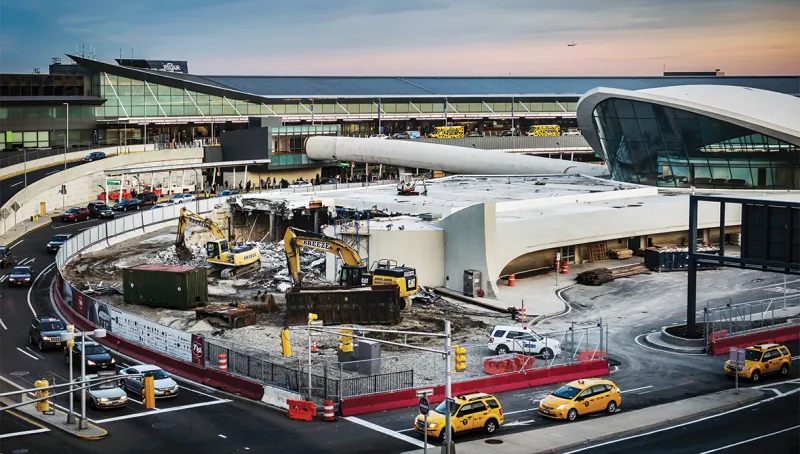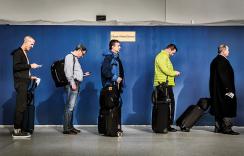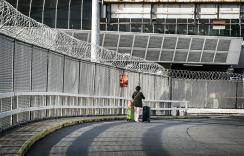
Photographs by Dina Litovsky
When Bryan Rowan enters LaGuardia Airport, he begins mentally renovating. “It’s really too bad about this,” he says, gesturing to a low-ceilinged food court in Terminal B. “It all got redone recently to make the concessions more of a draw, but nothing can change the fact that these places are presecurity.” For Rowan, a financial model man behind the terminal’s $4 billion rebuild, a presecurity food court is like filet mignon cooked well done: Potential is a terrible thing to waste.
As we amble down a hallway toward Gate D security, Rowan explains that “this Central Terminal Building was designed in the 1960s.” And it was designed for half the current passenger volume. The CTB (the formal name for the central terminal) curves in a wide C shape, affording plenty of room for shops and restaurants. From the main building four narrow concourses extend like concrete quills. Around each one jut bridges capped by constellations of narrow-body and regional jets.
There’s not enough room for two planes to back up at the same time, Rowan points out. There’s not enough room for almost anything. “See how this concourse funnels people into a single security lane?” We watch a bottleneck of passengers in the security line, stripping laptops from cases, shoes from feet, dignity from selves. “Back when LaGuardia was built, of course, there was no way to foresee what flying would look like post-9/11.”
Having postsecurity shops and restaurants — concessions, to the airport aficionado — began to matter financially after security became so much tighter. “Nonticketed people used to be allowed right up to the gate,” Rowan notes. “While they waited to pick someone up, they could wander to a restaurant in the terminal to have dinner, then walk up to the gate for coffee. They had the run of the place. Now the travel experience is such that people are not going to be able to relax until they’re through security.” We watch a line of holidaymakers snaking through the entrance to JetBlue’s gates. “Once that time uncertainty is gone, instead of grabbing a water on the run, a passenger might sit down and have lunch or stop for a drink.”

We amble past the Bowery Bay Tavern, a recent corporate attempt at a hipster pub. A couple of dozen beer taps flaunt local offerings, including Brooklyn Brewery. Despite the mostly empty bar stools (typical for presecurity), this attempt to bring the city into the airport is apparently a hot trend nationwide. Yet LaGuardia has five Auntie Anne’s pretzel stores and sometimes only Auntie Anne’s, depending on your gate. Either carbo-loaded passengers are more docile in a truculent plane takeoff line, or Auntie Anne is a legit rainmaker.
Neither is true, according to Rowan. And that matters. Just like the bars and food halls that are concentrated in the presecurity area, many things exist at LaGuardia that shouldn’t.
“The concessions are not optimally located from a revenue perspective right now,” Rowan explains. “They are where most of the room for growth is.” Whatever LaGuardia’s shops and restaurants bring in, the airport receives a portion to fund operations and capital. Buy a $4 bottle of Poland Spring from Hudson News and the airport gets roughly 72 cents, based on median figures from a recent survey of North American airports. On a pretzel dog ($3.99) with salsa cheese dip ($0.89), Auntie Anne’s might hand over 65 cents, but there isn’t enough heartburn in the world for that paltry amount of change to fund a world-class transportation hub.
America’s airports feel like bus stations because, broadly speaking, they are funded like bus stations. They don’t rely on taxpayer money, nor are they allowed to turn profits. Anything they earn must be reinvested into the facilities. The trouble for U.S. airports is that what they earn — through pennies on pretzels, rent from airlines, and a $4.50-per-ticket charge — isn’t nearly enough to keep pre-9/11 facilities safe, functioning, and ready for the 21st century. Overseas and in Canada airports have solved this problem by bringing in private investors, selling off operator rights, and taking control of, and often raising, the user fee. Those tactics either aren’t allowed in the U.S. or they haven’t been exercised. The result: places like LaGuardia. All day every day, thousands of people file onto airplanes headed to the U.S. guaranteed of one thing: Wherever they’re leaving is better than what lies ahead. LaGuardia Airport is North America’s worst, the perverse jewel in New York City’s Triple Crown of terrible airports. LaGuardia, Newark Liberty International, and John F. Kennedy International often sweep the bottom of U.S. rankings. LaGuardia, remarkably, has earned unanimous condemnation from airport nerds as the “worst in America,” uniting Travel + Leisure editors with the Points Guy, J.D. Power and Associates, and Frommer’s. T+L, perhaps the most discerning of the publications, gave “dilapidated” LaGuardia the “dubious honor of ranking the worst for the check-in and security process, the worst for baggage handling, the worst when it comes to providing wi-fi, the worst at staff communication, and the worst design and cleanliness.” It’s also worst for on-time performance and cancellations, says the Points Guy, and has somehow declined in overall quality since 2014. Welcome to the greatest city in the world.
“If I blindfolded someone and took them at two in the morning into the airport in Hong Kong and said, ‘Where do you think you are?’ they’d say, ‘This must be America; it’s a modern airport,’” Joe Biden, then vice president, told a crowd in Philadelphia at a 2014 Amtrak engine unveiling. (With infrastructure photo ops, U.S. politicians have to take what they can get.) “If I blindfolded you and took you to LaGuardia Airport in New York, you would think, ‘I must be in some third-world country.’” The audience broke out in laughter. Biden pressed the point. “I’m not joking.”
Even in the petty world of tristate politics, the officials in charge of LaGuardia didn’t come to its defense. “I agree with him,” said Patrick Foye, executive director of the Port Authority of New York and New Jersey, which runs the region’s major airports, bridges, ports, and roadways on its own balance sheet. New York Governor Andrew Cuomo has called LaGuardia a disgrace.
But at least LaGuardia is trying. The Central Terminal Building is set for the scrapyard, and its massive new replacement is budgeted to cost $4 billion, the main piece of an $8 billion overhaul plan. Frasca & Associates — the transport finance firm where Bryan Rowan has worked since college — joined the LaGuardia project in 2012 and supported the years-long process of evaluating bids to select a developer. What makes this project special is that the developer not only pours the concrete for the new LaGuardia, it owns the concrete — for the next 35 years, at least.
On June 1, 2016, the 35-year lease on Terminal B transferred from the Port Authority to an international consortium of private companies, winners of a long and competitive bidding war. They’ve promised a 21st-century LaGuardia that’s bigger, cleaner, easier to get to, and makes much more money, benefiting both the investors and the region. By 2021, LaGuardia should no longer suck. If all goes as planned — admittedly, that’s a big if — passengers will be able to swiftly exit taxis or meet their Uber drivers via an extra level for traffic, revel in three times the current Terminal B security screening capacity, walk to the Delta Air Lines terminal without going outside, and relax with a cocktail and nonpretzel-based meal postsecurity. Luxuries, one imagines, will abound in the terminal just as puddles used to proliferate on the floors when it rained.
How all this gets paid for is the job of Frasca & Associates. Rowan has spent a decade with the firm, specializing in financing airports. He does not rustle up capital from investors; instead, he works out the ideal combination of municipal bonds, taxable debt, equity offerings, cash flow, fees, leverage, creditworthiness, and more that puts a project into motion and sustains it. His and the firm’s presence at LaGuardia is a sign that this airport, and perhaps American airports as a whole, are finally ready to enter the modern age — an entrance delayed, experts say, by a nearly 70-year game of catch-up.
American aviation peaked high and early. The age of flight began in 1903 with 12 airborne seconds over a windswept Kitty Hawk, North Carolina. Four years later a Brazilian in France debuted what would become the first series-production aircraft, capable of a searing 75 miles per hour. The French weaponized airplanes during World War I, and Americans continue to perfect the art. The Kim Kardashian of the sky — first in fame, one might say — was the Red Baron, the German ace who downed 80 rivals before taking a bullet to the heart over a village near the Somme River. Once again, what Europe did first, the U.S. did better: The 1920s and ’30s were the era of celebrity pilots like Amelia Earhart and Charles Lindbergh. Initial ventures into commercial aviation abruptly halted as World War II began and U.S. aviation became military aviation. When the war ended, Europe and its allies across the pond refocused on commercial air travel. The aeronautics industry began branching into two missions: flying civilians for money and transporting weapons for war.
Americans took to the skies. Too many, in fact, for the converted military airfields and early civilian marine terminals. Air traffic nearly doubled between 1946 and 1955, according to government figures. Then came a technological revolution — the most important since Wilbur Wright’s 12 glorious seconds aloft.
The jet age began in the late 1950s and rendered existing infrastructure obsolete. Planes became bigger, faster, louder, and cheaper to operate. American Airlines’ first transcontinental route spirited passengers from New York to San Francisco — nonstop! — in a mere five hours, for 25 percent less than a ticket on the older-generation, piston-engine airships. In their place, Boeing 707s and McDonnell Douglas DC-9s arced coast to coast, and Pan Am stewardesses shook martinis for passengers in the smoking section.

American factories churned out jet planes faster than developers could build places to take off, land, and hangar them. Enter: the lag. By 1955 the strain on existing air facilities and the inadequacy of flight traffic controls compelled president Dwight Eisenhower to enlist three private institutions and several advisers — military and civilian — to make a long-range plan for controlling jet-age chaos and upgrading propeller-era systems. “Much of our airspace is already overcrowded,” the committee concluded. “The development of airports, navigation aids, and especially the air traffic control system is lagging far behind both aeronautical development and the needs of our mobile population and industry.” In the previous five years, 65 midair collisions occurred — all involving personal planes — killing scores. Airliners reported an average of four near misses per day.
Within months Congress funded the nation’s first modern air traffic control system: radar, radio, 40 control towers, and illuminated runways for the busiest routes and airports. Order was imposed, and flying got safer.
Sixty years later North American airports and carriers are the world’s safest: The risk of crashing is roughly one in 10 million, according to 2015 data from the International Air Transport Association. This is an important caveat to the contention that America’s airports suck. Any mode of transport that can operate — never mind fly, with a human pilot — daily for 2,700 years before failing is the opposite of suck.
Starting in the 1950s safety took priority over passenger experience, insufficient airport capacity, and development for the future. Then, as now, nearly all U.S. airports had constrained spendable assets, and operators picked safety over bathroom tiles and proactive expansions. “We cannot go on year after year expanding all our airport facilities,” a Civil Aeronautics Board official declared in a 1955 speech. “We have a right to expect a kind of aircraft to be developed that will be more economical of facilities on the ground.”
U.S. cities “have been continuously playing catch-up since World War II,” historian Janet Bednarek writes in Airports, Cities, and the Jet Age. “While many cities came out of WWII with converted military bases that helped absorb the first new waves of air traffic, unexpectedly large growth in passenger traffic, new technologies, and changes in the rules of the game challenged even the best airport planning. Civic leaders expanded many times with the expectation that the facilities could then meet demand for decades.” But many airports were congested within a few years of wrapping up construction. Others, Bednarek writes, baked aggressive passenger traffic growth into their project funding models — the airport huckster’s version of supply-siding a tax cut to reach “revenue neutral.”
Local governments strove to close the lag, Bednarek explains, as “airports became logical places for cities to promote themselves to national and even international markets.” They built runways — big ones — and commissioned terminals that would become landmarks of architecture. In 1962, for example, New York’s Port Authority opened the TWA Flight Center at Idlewild Airport (now JFK). A prominent architect described the structure, designed by Eero Saarinen, as the “Grand Central of the jet age.” It took seven years to build, and as many to become obsolete. Boeing’s 747 kicked off the so-called wide-body war in 1970, compelling airports to retrofit for the new planes’ expansive girth. But in a few short years, that war was over. Later, post-9/11 fuel prices made jumbo jets impractical for all but the longest hauls.
Maintaining a major airport could feel like a Sisyphean task. America’s newest — Denver International — opened in 1995 and has expanded twice since then. Chasing capricious traveler flows and yo-yoing plane sizes with a seven- to ten-year building handicap is a nearly impossible mission, and one that the U.S. is performing worse than nearly every other first-world country, not to mention many in the developing world.
The airports goeth before the fall, futurist economists contend. America’s air infrastructure requires $75 billion in investment through 2019 to keep up with passenger and cargo growth, rehabilitate existing facilities, and support aircraft development, according to the North American branch of trade group Airports Council International (ACI-NA). Of course, a high estimate would be self-serving given the constituency the organization represents. Yet any frequent flier can attest to the fact that America’s airports have fallen behind.
“When you fly into an airport like LaGuardia, what do you see when you land? An airport in desperate need of repair,” ACI-NA president and CEO Kevin Burke told me at the organization’s recent conference in Washington. The biggest issue: funding, especially the $4.50 user fee, or passenger facility charge (PFC), that U.S. airports borrow against for development projects. Instituted in 1992 at $3 and increased to $4.50 in 2001, the fee can only be raised through an act of Congress. Since 2001, passenger volume has climbed while inflation has diminished the fee’s real value to $2.20. Congress has refused to heed the industry’s call to raise the cap, seeing the fee as a tax that would reduce flying. This argument infuriates Burke and U.S. airport operators, who typically compare it to checked-bag fees. (Airlines, unlike the facilities they fly in and out of, can add charges without lawmakers’ go-ahead).
Canada allows airports to dictate their own passenger fees: Set them too high, and the market will punish that airport accordingly. Nearly all are multiples of the $4.50 maximum allowed at U.S. airports. Calgary International, for example, charges each passenger C$30 ($22.82); Toronto adds C$20; and Bathurst, New Brunswick, tops the chart at C$40 for the privilege of flying from its tiny gateway. Furthermore, Canadian airports are mostly run by private organizations, which pay the government for long-term leases on the land. “When they want to build a runway, they build a runway,” Burke says, shaking his head. “And our airports are competing with one hand tied behind their back, thanks to Congress.”
The ACI-NA isn’t lobbying for Canadian-style fee freedom or even that level of increase. A $4 raise to $8.50 per ticket, Burke says, “would be like manna from heaven.” But with an antitax, Republican-controlled House, Senate, and White House, it’s about as likely to arrive.
Airlines don’t get veto power over passenger fees, but in practice their lobbying has prevented any increase. “Our position is that we want our costs to be as low as we can,” says Delta’s Christine Kennedy, general manager for network planning and partnerships. At the ACI-NA conference she presented her airline’s “extraordinary” profit growth to attendees. “I understand the arguments for the PFCs, but for me it’s just a number in the P&L,” she says. “Obviously, the lower the better.”
By preventing airports from raising sufficient capital the traditional way — fees per ticket — airlines essentially hold the purse strings for U.S. airport development. “We absolutely care about passenger experience,” Kennedy asserts. “You can see that in the money Delta spent on JFK” — nearly $1.4 billion to overhaul Terminal 4, which serves the airline exclusively. Airlines have positioned themselves as the only source of capital and, in doing so, have taken enormous control over U.S. airports. If Delta, American, or United is signing the check for a new terminal, you can bet the improvements won’t benefit passengers flying JetBlue, Air Canada, or Spirit. And that’s a problem for any airport with a crumbling central security screening area or multiairline runways.
Privatization hasn’t taken off in the U.S., because of the country’s unique structural and philosophical barriers. In discussing airport financing, “the U.S. is different from the rest of the world in some key respects,” says Perry Offutt, a managing director at Macquarie Infrastructure and Real Assets in New York. Macquarie is invested in airports in Brussels; Glasgow and Aberdeen, Scotland; Delhi and Hyderabad, India; and Hobart, Australia, among others, and is a leader in financing public-private infrastructure projects worldwide. “Despite the country’s focus on capitalism, some local entities, which control most U.S. infrastructure, are reluctant to privatize because they worry about the potential impact on key constituents of changing the status quo.”

Local jurisdiction over airports means that fundamental change, such as privatization, is enormously complex. It involves a range of stakeholders whose interests don’t necessarily align, including unions, mayors, city councils, and state governors, for example. “Those who oppose public-private partnerships often suggest that private capital is profiting at the expense of the public,” Offutt says. What that misses, he explains, are the enormous efficiencies private operators can bring to bear and the risk transfer from governments to investors. If a new terminal development goes sideways, for example, the Macquaries of the world are left holding the bag, not taxpayers.
But those arguments failed to overcome the hurdles of the U.S. market — until LaGuardia, that is. America’s infrastructure philosophy — for the people, by the people — sounds democratic, but the result for airports is the opposite. Block off private investment, and you’re left with whatever the airlines throw your way and (over)leveraging against capped user fees. As the manager of one midsize, overcapacity U.S. airport puts it, “Airport financing is a hot mess right now.”
Why not accept this perverse American exceptionalism and treat airports as the bus terminals of the skies? People still fly, after all. Consider LaGuardia in its direst state: Rain outside means rain inside the terminals, with leaks cleverly siphoned into inverted traffic cones taped to rubber tubes that run into garbage bins. Yet the airport still kicked off $35 million in operating income in 2015. Together the Port Authority’s Big Three are more than the Triple Crown of terrible places to be alive in. They’re also the world’s second-most-popular airport system (122 million passengers in 2015), behind London’s quartet of Heathrow-Gatwick-Stansted-Luton (150 million), according to the Port Authority and the CAPA Center for Aviation.
For LaGuardia, business is up. More than 1 million additional people passed through its doors in 2015 (the most recent statistics available) versus the previous year. That’s 175 percent of the airport’s intended capacity. And unlike many less fortunate cities in the U.S., travelers to and from New York have options. It’s broke — but why fix it?
“There is a sense of pride one wants to have in their public assets and infrastructure,” says Jane Garvey, head of the Federal Aviation Administration in the Clinton administration and one of the people tasked with rebuilding LaGuardia. “Airports are our gateways. You want the gateway to be something you can be proud of.”
Garvey is chairman of North America for Meridiam, a leading, Paris-based infrastructure investment firm. In 2011 the Port Authority solicited private sector interest in overhauling LaGuardia, and Meridiam joined forces to bid with international specialists in airport construction (Skanska, Walsh Group), design (HOK, WSP Parsons Brinckerhoff), and operations (Vantage Airport Group). Together they became LaGuardia Gateway Partners. Bryan Rowan and his Frasca & Associates colleagues spent years analyzing the numbers and stress-testing the models of each bidder, just one of many professional contractors to the Port Authority in the massive leap into airport privatization. In 2015, LaGuardia Gateway Partners won the landmark contract; it took over the Central Terminal Building lease last June. It vows to stop rain from falling inside the terminals.
“We had been holding our breath for two years, and I’m sure you could hear the sighs of relief and cries of joy all over Manhattan,” says Rebecca Catley, Vantage’s senior director of communications, recalling that Thursday in May 2015 when the Port Authority picked her group. “It was very, very exciting.” Three finalists remained in competition for the contract, all of them experienced international groups that had invested years of effort and millions of dollars in wooing the Port Authority. Leaders gathered at the World Trade Center to hear their fate, and each team was assigned a color. “We were the purple team,” Catley remembers, “and we all bought purple ties, purses, and scarves for that extra bit of good luck. I don’t even remember if we went out to celebrate, but I’m sure we raised a glass that night.”
Patching the leaky roof and fixing other egregious issues was the first $5 million line item in LaGuardia’s CTB overhaul. The next $3.2 billion should turn the “stepchild of New York airports,” as one Port Authority official calls it, into “world class.” Vantage, Meridiam, and Skanska brought $200 million in capital to the table, but insiders say the Port Authority wasn’t after their money; it wanted their expertise.

“The Port Authority, having experienced significant delays and cost overruns at the World Trade Center — that was one of the main drivers for soliciting an alternative delivery method for LaGuardia,” says an insider. “They saw how awry things went and thought, ‘We could use some people who know what they’re doing.’ Bringing in private partners was a massive decision, and not everyone was in support of it.”
It’s a testament to good governance that the Port Authority learned a lesson. Many public entities have undertaken big infrastructure projects and bungled them; the Port Authority applied its experience to make a better plan for the next project. From early on in the process, it carved out a role for private partners in the design and construction of LaGuardia 2.0. That matters to the eventual outcome, according to Meridiam’s Garvey and Marie-Liesse Marc, Vantage’s vice president of acquisitions and asset management.
“As an operator, the best way to deliver really good customer experience is to have input in the design from the beginning,” Marc explains. “In the case of LaGuardia, we had to think the Port Authority would lead the project to a successful outcome, because it’s going to be a complex process. Partnerships like these are going to be critical in the much-needed development of the U.S. market: An experienced operator focused on deliverability looks ten years, 20 years in the future and asks, ‘Am I overbuilding? Am I underbuilding?’ And when you have a deliverable project, it’s financeable.”
Rowan knows the LaGuardia project can be financed, and he is convinced it’s deliverable. The companies running the show are pros, in his view. As for their plan: Hello, postsecurity dining, drinking, and shopping. The vast majority (95 percent) of concessions will be accessible after the ritual strip search; Rowan thinks this will pay off for investors and travelers. After all, only happy passengers shop. “From the airport roads to the terminals to the airside, the redevelopment should significantly improve every aspect of the passenger experience,” he writes in an e-mail. “As a New Yorker, and as someone in the industry, I’m beyond excited to witness this transformation taking place.”
So are investors worldwide, who are itching to put money in this desperately undercapitalized, highly stable long-term market. That’s where hope lies for America’s airports and the 900 million people who fly through them every year. Airports could be awash in cash for redevelopment if their controlling entities choose to take it (and give up a little control in the process).
“We have clearly underinvested in infrastructure in this country,” Garvey says. “There has been a distrust of private entities on the part of public officials. As more and more P3 [public-private partnerships] are built and operated well, public opinion may change and be more embracing of the delivery mode.” This model, she adds, “is as much about shifting risk and fostering innovation as it is financial.”
For that reason, the infrastructure cash tsunami promised by Donald Trump elicits wariness from many airport experts. Governments have poor track records putting public capital to work efficiently, rarely delivering projects on time and on budget. Entire administrations change over the course of a terminal or runway rebuild, putting projects at the whim of politicians — which, as the Port Authority has learned, is the worst way to do them well.
On January 4, a year and a half into New York’s privatization experiment with LaGuardia, Governor Cuomo made an announcement: The Triple Crown’s days are numbered. “We are New York, and we remember the bravado that built this state in the first place,” he told a large audience. “That is the attitude that will take JFK and turn it into the 21st-century airport that we deserve.”
Potential private investment in the JFK project: $7 billion.
Leanna Orr is the Global Content Director of Institutional Investor’s Investor Intelligence Network.





